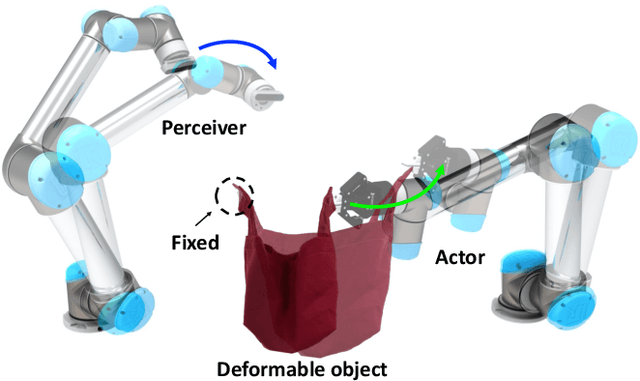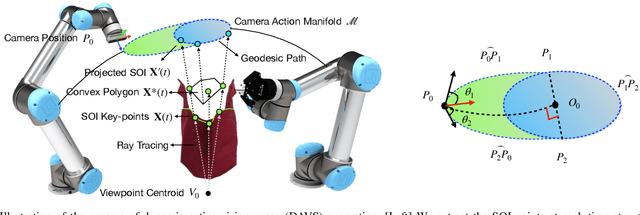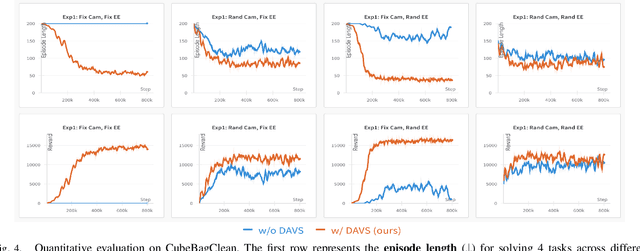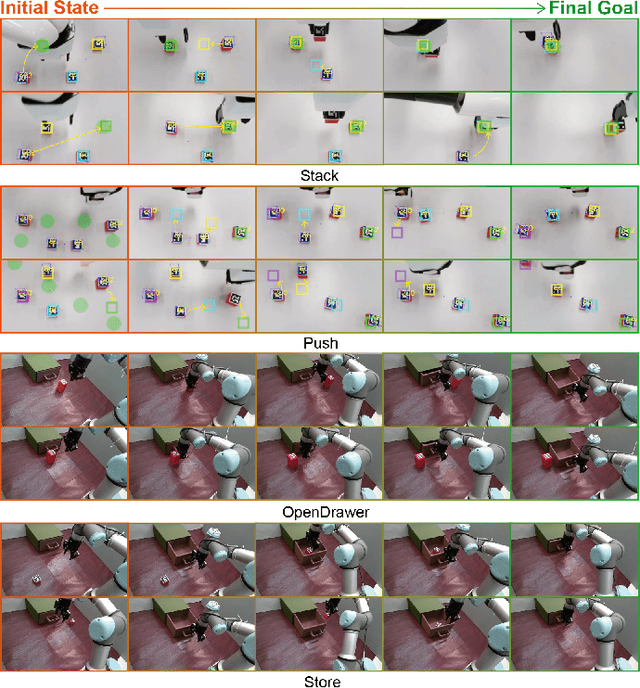David Navarro-Alarcon
Prescribed Performance Control of Deformable Object Manipulation in Spatial Latent Space
Oct 16, 2025Abstract:Manipulating three-dimensional (3D) deformable objects presents significant challenges for robotic systems due to their infinite-dimensional state space and complex deformable dynamics. This paper proposes a novel model-free approach for shape control with constraints imposed on key points. Unlike existing methods that rely on feature dimensionality reduction, the proposed controller leverages the coordinates of key points as the feature vector, which are extracted from the deformable object's point cloud using deep learning methods. This approach not only reduces the dimensionality of the feature space but also retains the spatial information of the object. By extracting key points, the manipulation of deformable objects is simplified into a visual servoing problem, where the shape dynamics are described using a deformation Jacobian matrix. To enhance control accuracy, a prescribed performance control method is developed by integrating barrier Lyapunov functions (BLF) to enforce constraints on the key points. The stability of the closed-loop system is rigorously analyzed and verified using the Lyapunov method. Experimental results further demonstrate the effectiveness and robustness of the proposed method.
HuBE: Cross-Embodiment Human-like Behavior Execution for Humanoid Robots
Aug 26, 2025Abstract:Achieving both behavioral similarity and appropriateness in human-like motion generation for humanoid robot remains an open challenge, further compounded by the lack of cross-embodiment adaptability. To address this problem, we propose HuBE, a bi-level closed-loop framework that integrates robot state, goal poses, and contextual situations to generate human-like behaviors, ensuring both behavioral similarity and appropriateness, and eliminating structural mismatches between motion generation and execution. To support this framework, we construct HPose, a context-enriched dataset featuring fine-grained situational annotations. Furthermore, we introduce a bone scaling-based data augmentation strategy that ensures millimeter-level compatibility across heterogeneous humanoid robots. Comprehensive evaluations on multiple commercial platforms demonstrate that HuBE significantly improves motion similarity, behavioral appropriateness, and computational efficiency over state-of-the-art baselines, establishing a solid foundation for transferable and human-like behavior execution across diverse humanoid robots.
Instruction-Augmented Long-Horizon Planning: Embedding Grounding Mechanisms in Embodied Mobile Manipulation
Mar 11, 2025Abstract:Enabling humanoid robots to perform long-horizon mobile manipulation planning in real-world environments based on embodied perception and comprehension abilities has been a longstanding challenge. With the recent rise of large language models (LLMs), there has been a notable increase in the development of LLM-based planners. These approaches either utilize human-provided textual representations of the real world or heavily depend on prompt engineering to extract such representations, lacking the capability to quantitatively understand the environment, such as determining the feasibility of manipulating objects. To address these limitations, we present the Instruction-Augmented Long-Horizon Planning (IALP) system, a novel framework that employs LLMs to generate feasible and optimal actions based on real-time sensor feedback, including grounded knowledge of the environment, in a closed-loop interaction. Distinct from prior works, our approach augments user instructions into PDDL problems by leveraging both the abstract reasoning capabilities of LLMs and grounding mechanisms. By conducting various real-world long-horizon tasks, each consisting of seven distinct manipulatory skills, our results demonstrate that the IALP system can efficiently solve these tasks with an average success rate exceeding 80%. Our proposed method can operate as a high-level planner, equipping robots with substantial autonomy in unstructured environments through the utilization of multi-modal sensor inputs.
* 17 pages, 11 figures
Encircling General 2-D Boundaries by Mobile Robots with Collision Avoidance: A Vector Field Guided Approach
Jan 04, 2025Abstract:The ability to automatically encircle boundaries with mobile robots is crucial for tasks such as border tracking and object enclosing. Previous research has primarily focused on regular boundaries, often assuming that their geometric equations are known in advance, which is not often the case in practice. In this paper, we investigate a more general case and propose an algorithm that addresses geometric irregularities of boundaries without requiring prior knowledge of their analytical expressions. To achieve this, we develop a Fourier-based curve fitting method for boundary approximation using sampled points, enabling parametric characterization of general 2-D boundaries. This approach allows star-shaped boundaries to be fitted into polar-angle-based parametric curves, while boundaries of other shapes are handled through decomposition. Then, we design a vector field (VF) to achieve the encirclement of the parameterized boundary, wherein a polar radius error is introduced to measure the robot's ``distance'' to the boundary. The controller is finally synthesized using a control barrier function and quadratic programming to mediate some potentially conflicting specifications: boundary encirclement, obstacle avoidance, and limited actuation. In this manner, the VF-guided reference control not only guides the boundary encircling action, but can also be minimally modified to satisfy obstacle avoidance and input saturation constraints. Simulations and experiments are presented to verify the performance of our new method, which can be applied to mobile robots to perform practical tasks such as cleaning chemical spills and environment monitoring.
Non-Prehensile Tool-Object Manipulation by Integrating LLM-Based Planning and Manoeuvrability-Driven Controls
Dec 09, 2024Abstract:The ability to wield tools was once considered exclusive to human intelligence, but it's now known that many other animals, like crows, possess this capability. Yet, robotic systems still fall short of matching biological dexterity. In this paper, we investigate the use of Large Language Models (LLMs), tool affordances, and object manoeuvrability for non-prehensile tool-based manipulation tasks. Our novel method leverages LLMs based on scene information and natural language instructions to enable symbolic task planning for tool-object manipulation. This approach allows the system to convert the human language sentence into a sequence of feasible motion functions. We have developed a novel manoeuvrability-driven controller using a new tool affordance model derived from visual feedback. This controller helps guide the robot's tool utilization and manipulation actions, even within confined areas, using a stepping incremental approach. The proposed methodology is evaluated with experiments to prove its effectiveness under various manipulation scenarios.
Revolutionizing Packaging: A Robotic Bagging Pipeline with Constraint-aware Structure-of-Interest Planning
Mar 15, 2024



Abstract:Bagging operations, common in packaging and assisted living applications, are challenging due to a bag's complex deformable properties. To address this, we develop a robotic system for automated bagging tasks using an adaptive structure-of-interest (SOI) manipulation approach. Our method relies on real-time visual feedback to dynamically adjust manipulation without requiring prior knowledge of bag materials or dynamics. We present a robust pipeline featuring state estimation for SOIs using Gaussian Mixture Models (GMM), SOI generation via optimization-based bagging techniques, SOI motion planning with Constrained Bidirectional Rapidly-exploring Random Trees (CBiRRT), and dual-arm manipulation coordinated by Model Predictive Control (MPC). Experiments demonstrate the system's ability to achieve precise, stable bagging of various objects using adaptive coordination of the manipulators. The proposed framework advances the capability of dual-arm robots to perform more sophisticated automation of common tasks involving interactions with deformable objects.
Interactive Perception for Deformable Object Manipulation
Mar 08, 2024



Abstract:Interactive perception enables robots to manipulate the environment and objects to bring them into states that benefit the perception process. Deformable objects pose challenges to this due to significant manipulation difficulty and occlusion in vision-based perception. In this work, we address such a problem with a setup involving both an active camera and an object manipulator. Our approach is based on a sequential decision-making framework and explicitly considers the motion regularity and structure in coupling the camera and manipulator. We contribute a method for constructing and computing a subspace, called Dynamic Active Vision Space (DAVS), for effectively utilizing the regularity in motion exploration. The effectiveness of the framework and approach are validated in both a simulation and a real dual-arm robot setup. Our results confirm the necessity of an active camera and coordinative motion in interactive perception for deformable objects.
Bimanual Deformable Bag Manipulation Using a Structure-of-Interest Based Latent Dynamics Model
Jan 21, 2024Abstract:The manipulation of deformable objects by robotic systems presents a significant challenge due to their complex and infinite-dimensional configuration spaces. This paper introduces a novel approach to Deformable Object Manipulation (DOM) by emphasizing the identification and manipulation of Structures of Interest (SOIs) in deformable fabric bags. We propose a bimanual manipulation framework that leverages a Graph Neural Network (GNN)-based latent dynamics model to succinctly represent and predict the behavior of these SOIs. Our approach involves constructing a graph representation from partial point cloud data of the object and learning the latent dynamics model that effectively captures the essential deformations of the fabric bag within a reduced computational space. By integrating this latent dynamics model with Model Predictive Control (MPC), we empower robotic manipulators to perform precise and stable manipulation tasks focused on the SOIs. We have validated our framework through various empirical experiments demonstrating its efficacy in bimanual manipulation of fabric bags. Our contributions not only address the complexities inherent in DOM but also provide new perspectives and methodologies for enhancing robotic interactions with deformable objects by concentrating on their critical structural elements. Experimental videos can be obtained from https://sites.google.com/view/bagbot.
Implicit Subgoal Planning with Variational Autoencoders for Long-Horizon Sparse Reward Robotic Tasks
Dec 25, 2023



Abstract:The challenges inherent to long-horizon tasks in robotics persist due to the typical inefficient exploration and sparse rewards in traditional reinforcement learning approaches. To alleviate these challenges, we introduce a novel algorithm, Variational Autoencoder-based Subgoal Inference (VAESI), to accomplish long-horizon tasks through a divide-and-conquer manner. VAESI consists of three components: a Variational Autoencoder (VAE)-based Subgoal Generator, a Hindsight Sampler, and a Value Selector. The VAE-based Subgoal Generator draws inspiration from the human capacity to infer subgoals and reason about the final goal in the context of these subgoals. It is composed of an explicit encoder model, engineered to generate subgoals, and an implicit decoder model, designed to enhance the quality of the generated subgoals by predicting the final goal. Additionally, the Hindsight Sampler selects valid subgoals from an offline dataset to enhance the feasibility of the generated subgoals. The Value Selector utilizes the value function in reinforcement learning to filter the optimal subgoals from subgoal candidates. To validate our method, we conduct several long-horizon tasks in both simulation and the real world, including one locomotion task and three manipulation tasks. The obtained quantitative and qualitative data indicate that our approach achieves promising performance compared to other baseline methods. These experimental results can be seen in the website \url{https://sites.google.com/view/vaesi/home}.
Learning Rhythmic Trajectories with Geometric Constraints for Laser-Based Skincare Procedures
Dec 21, 2023Abstract:The increasing deployment of robots has significantly enhanced the automation levels across a wide and diverse range of industries. This paper investigates the automation challenges of laser-based dermatology procedures in the beauty industry; This group of related manipulation tasks involves delivering energy from a cosmetic laser onto the skin with repetitive patterns. To automate this procedure, we propose to use a robotic manipulator and endow it with the dexterity of a skilled dermatology practitioner through a learning-from-demonstration framework. To ensure that the cosmetic laser can properly deliver the energy onto the skin surface of an individual, we develop a novel structured prediction-based imitation learning algorithm with the merit of handling geometric constraints. Notably, our proposed algorithm effectively tackles the imitation challenges associated with quasi-periodic motions, a common feature of many laser-based cosmetic tasks. The conducted real-world experiments illustrate the performance of our robotic beautician in mimicking realistic dermatological procedures; Our new method is shown to not only replicate the rhythmic movements from the provided demonstrations but also to adapt the acquired skills to previously unseen scenarios and subjects.
 Add to Chrome
Add to Chrome Add to Firefox
Add to Firefox Add to Edge
Add to Edge